 Global| Feb 24 2006
Global| Feb 24 2006U.S. Durable Goods Orders Plunge Due To Aircraft
by:Tom Moeller
|in:Economy in Brief
Summary
Durable goods orders plunged 10.2% last month following an upwardly revised 2.5% increase during December. The drop far outpaced Consensus expectations for a 2.0% decline, however, the details of the report again portrayed a [...]
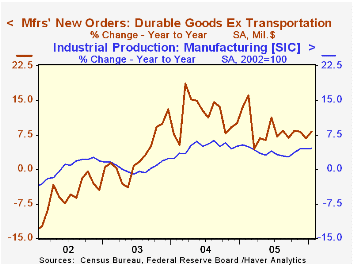
Durable goods orders plunged 10.2% last month following an upwardly revised 2.5% increase during December. The drop far outpaced Consensus expectations for a 2.0% decline, however, the details of the report again portrayed a constructive picture of activity in the factory sector.
Aircraft & parts orders, which had more than doubled during the prior three months, fell 60.3% m/m yet remained up 59.4% from January of 2005.
New orders for motor vehicles & parts also fell, by 3.3% (+0.9% y/y) and have been moving erratically sideways since late 2003.
Less the transportation sector altogether, durable goods orders rose 0.6% following an upwardly revised 1.9% increase during December and during the last six months have risen at an accelerated 16.4% annual rate.
Higher electrical equipment orders led the strength in January with a 2.7% (7.5% y/y) gain. Orders for fabricated metals (5.8% y/y) & primary metals (10.0% y/y) also rose but machinery orders reversed 2.5% (14.7% y/y) of an upwardly revised 9.5% December surge. Orders for computers & electronic products also slipped 0.4% (+2.2% y/y) due to an 11.0% (+4.0% y/y) plunge in computer orders.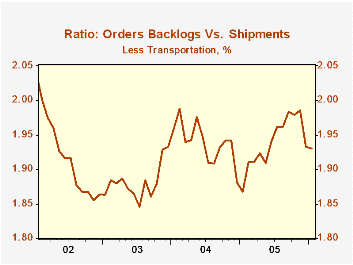
Orders for nondefense capital goods collapsed 20.0% due to the drop in aircraft but less aircraft, nondefense capital goods orders slipped just 0.4% after an upwardly revised 5.0% December surge.
Shipments of durable goods fell 1.3% (+6.5% y/y) after an upwardly revised 4.1% gain during December. Less the transportation sector shipments added 0.4% (6.8% y/y) to the upwardly revised 3.1% December increase.
Order backlogs slipped 0.8% (+16.0% y/y) but less transportation backlogs gained another 0.3% (10.4% y/y). The ratio of backlogs to shipments outside of transportation slipped and was squarely in the middle of the range of the last two years.
Durable inventories rose 0.3% (3.0% y/y).
| NAICS Classification | Jan | Dec | Y/Y | 2005 | 2004 | 2003 |
|---|---|---|---|---|---|---|
| Durable Goods Orders | -10.2% | 2.5% | 5.4% | 8.6% | 9.5% | 4.1% |
| Excluding Transportation | 0.6% | 1.9% | 8.3% | 8.6% | 11.7% | 3.1% |
| Nondefense Capital Goods | -20.0% | 2.0% | 10.2% | 20.0% | 11.0% | 4.2% |
| Excluding Aircraft | -0.4% | 5.0% | 6.5% | 10.7% | 9.5% | 4.8% |
by Carol Stone February 24, 2006
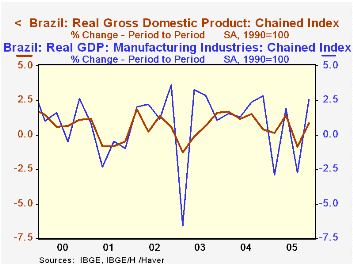
Brazil's economy expanded 1.4% in Q4 over a year prior and 2.3% for 2005 as a whole. The Q4 result, +0.8% seasonally adjusted, was apparently below some forecasters' expectations, but even so, it represented a turnaround from a 0.9% drop in Q3. The rebound in this latest quarter is widespread among industry groups and domestic spending.
Agriculture, for instance, gained 0.8% in Q4 after a -2.1% drop in Q3. Press reports describe that there have been drought conditions in the farming region in the south restraining activity in that sector and leaving the Q4/Q4 performance at a decline of 1.8%. The annual average was up 0.8% from 2004, but that year had shown good growth across the spectrum of Brazilian industry, making a slower pace in 2005 not surprising, but also not particularly alarming.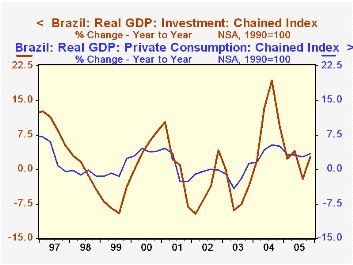
Industry activity did relatively better in Q4 than agriculture, as mining, manufacturing and construction all improved from Q3 weakness. Services industry output in Brazil did not decline in Q3, but merely experienced slower growth. However, the specific segments tied to goods production, such as wholesale and retail trade, transport and finance, did in fact decline in Q3, and then rebound in Q4.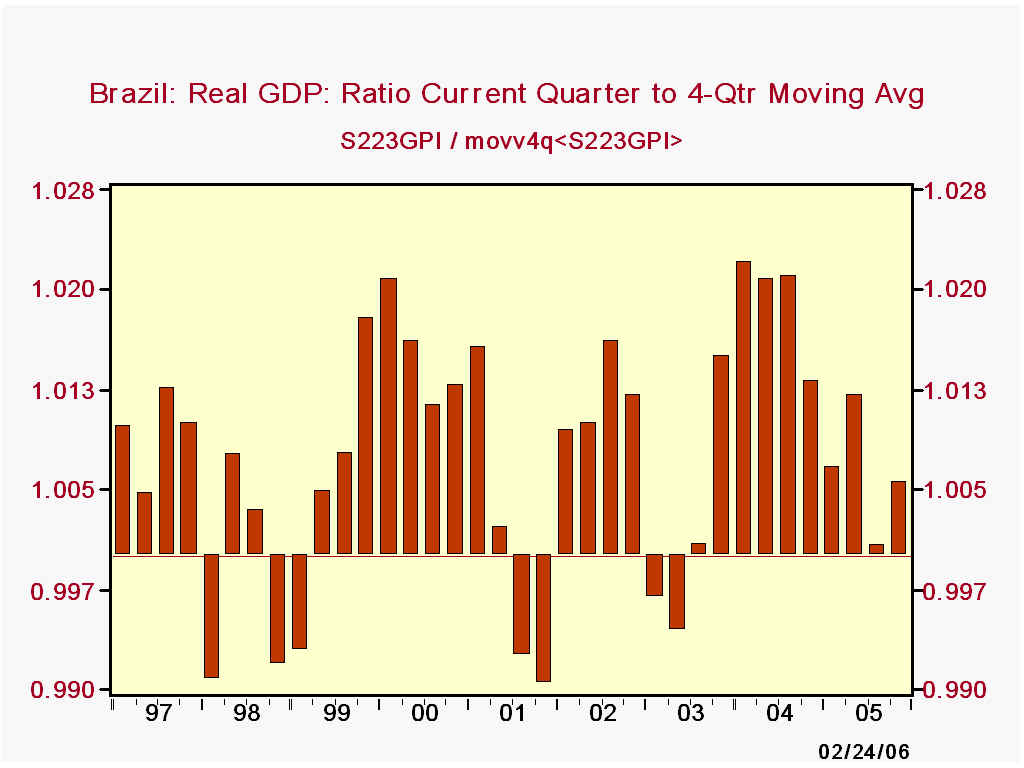
Overall, total GDP for the year 2005 saw slower growth than in 2004, down more than half at 2.3% versus 4.9% in 2004. A look at spending components might give some explanation. In 2004, several items were strong: investment demand and exports in particular. Investment grew 10.9%, its second highest growth rate in the 14-year history of these national accounts data, and exports gained 18.1%, their biggest gain. So some moderation in 2005 was probably to be expected. The last graph, however, indicates that there is a bit of upward movement heading into 2006. This graph shows the ratio of the current quarter's GDP level to a four-quarter moving average. Using features of the DLXVG3 software, we have drawn a "horizontal reference line" at 1, i.e., where the latest quarter is equal to the four-quarter moving average. Then we have formatted the series in bars, which point up and down from the horizontal reference. There we can see that Q4, despite its result less than forecasters had hoped, does look to be starting to climb up from the sluggish Q3 position.
| Brazil Index, 1990=100, % Changes* |
Quarter/Quarter
Year/- Year | 2005 | 2004 | 2003 | |||
|---|---|---|---|---|---|---|---|
| Q4 2005 | Q3 2005 | Q2 2005 | |||||
| Real GDP | 0.8 | -0.9 | 1.4 | 1.4 | 2.3 | 4.9 | 0.5 |
| Agriculture | 0.8 | -2.1 | 0.9 | -1.8 | 0.8 | 5.3 | 4.5 |
| Industry | 1.4 | -0.9 | 1.5 | 1.4 | 2.5 | 6.2 | 0.1 |
| Services | 0.7 | 0.3 | 0.7 | 1.8 | 2.0 | 3.3 | 0.6 |
| Private Consumption | 1.3 | 1.0 | 1.2 | 3.4 | 3.1 | 4.1 | -1.5 |
| Investment | 1.7 | -0.9 | 4.7 | 2.7 | 1.6 | 10.9 | -5.1 |
Tom Moeller
AuthorMore in Author Profile »Prior to joining Haver Analytics in 2000, Mr. Moeller worked as the Economist at Chancellor Capital Management from 1985 to 1999. There, he developed comprehensive economic forecasts and interpreted economic data for equity and fixed income portfolio managers. Also at Chancellor, Mr. Moeller worked as an equity analyst and was responsible for researching and rating companies in the economically sensitive automobile and housing industries for investment in Chancellor’s equity portfolio. Prior to joining Chancellor, Mr. Moeller was an Economist at Citibank from 1979 to 1984. He also analyzed pricing behavior in the metals industry for the Council on Wage and Price Stability in Washington, D.C. In 1999, Mr. Moeller received the award for most accurate forecast from the Forecasters' Club of New York. From 1990 to 1992 he was President of the New York Association for Business Economists. Mr. Moeller earned an M.B.A. in Finance from Fordham University, where he graduated in 1987. He holds a Bachelor of Arts in Economics from George Washington University.






